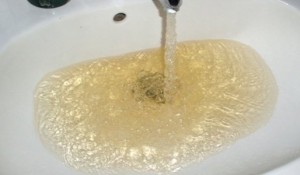What is Tannin in Drinking Water
 Tannins are natural organic materials that are usually the by-products of the natural break down of decaying vegetation and sometimes the product of “natures” fermentation process as opposed to the tannins found in wines. They are created as water passes through peaty soil and decaying vegetation. This causes the water to have a faint yellow to tea-like color, and can cause yellow staining on fabrics, fixtures, china and laundry. Tannin may give an unpleasant aftertaste to water. It may also cause water to have a musty or earthy odor. Tannins are sometimes referred to as fulvic or humic acids and are more common in surface water supplies, lake or river sources and shallow wells than in deep wells. Water in marshy, low-lying, or coastal areas is also more susceptible to tannins.
Tannins are natural organic materials that are usually the by-products of the natural break down of decaying vegetation and sometimes the product of “natures” fermentation process as opposed to the tannins found in wines. They are created as water passes through peaty soil and decaying vegetation. This causes the water to have a faint yellow to tea-like color, and can cause yellow staining on fabrics, fixtures, china and laundry. Tannin may give an unpleasant aftertaste to water. It may also cause water to have a musty or earthy odor. Tannins are sometimes referred to as fulvic or humic acids and are more common in surface water supplies, lake or river sources and shallow wells than in deep wells. Water in marshy, low-lying, or coastal areas is also more susceptible to tannins.
Are there any negative health effects to consuming Tannin?
Tannins are considered an aesthetic problem. While they may make water unappealing to drink and stain laundry, they do not present a health concern.
Can I test my water for Tannins?
Tannins create a light yellow to dark brown discoloration in the water. A simple test for tannin involves filling a clear glass with water and letting it sit overnight. If the color settles to the bottom of the glass, the discoloration is most likely caused by iron and/or manganese and not tannins. If the intensity of the color remains intact, it is most likely caused by tannins. If you suspect your water may contain tannin and wish to know how much tannin is present in your water, contact us here at Muskoka Clean Water or bring a bottle of your water into our store located at 77 Centre N., Huntsville, Ont. You may also wish to test for sulfates, alkalinity, iron, total dissolved solids (TDS) and hardness, as these may help determine which treatment method(s) will be most effective for your situation. There is another reason to test for iron along with tannins; iron creates a false positive for tannins and must be subtracted from the tannin result to determine that true tannin concentration.
What can I use to remove Tannins from my water?
Common tannin treatment uses an organic scavenging anion exchange resin. The anion resin is sensitive to hardness, so some systems include a water softener as pre-treatment however in Muskoka as our water is generally soft this is not needed. The water softener extends the life of the anion resin and increases tannin absorption when there is hard water. Anion exchange resin systems should be regenerated occasionally with a salt water solution to improve the effectiveness of the resin. Anion exchange resin systems can also change the chloride, alkalinity and sulfate levels of the water, so you may wish to monitor these substances more closely once the system is installed. Oxidation and filtration is another method to remove tannins, but is not as simple as anion exchange and softening. At Muskoka Clean Water we will analyze your water and recommend the best system for you. It should be noted that tannins can sometimes interfere with equipment used to treat other water problems. For example, the resins or medias in iron filters, cation exchange filters and neutralizing filters can become coated by the tannins, and may no longer work properly. It may be useful to test for tannins (using the “clear glass” method described above) before installing these types of water treatment devices.